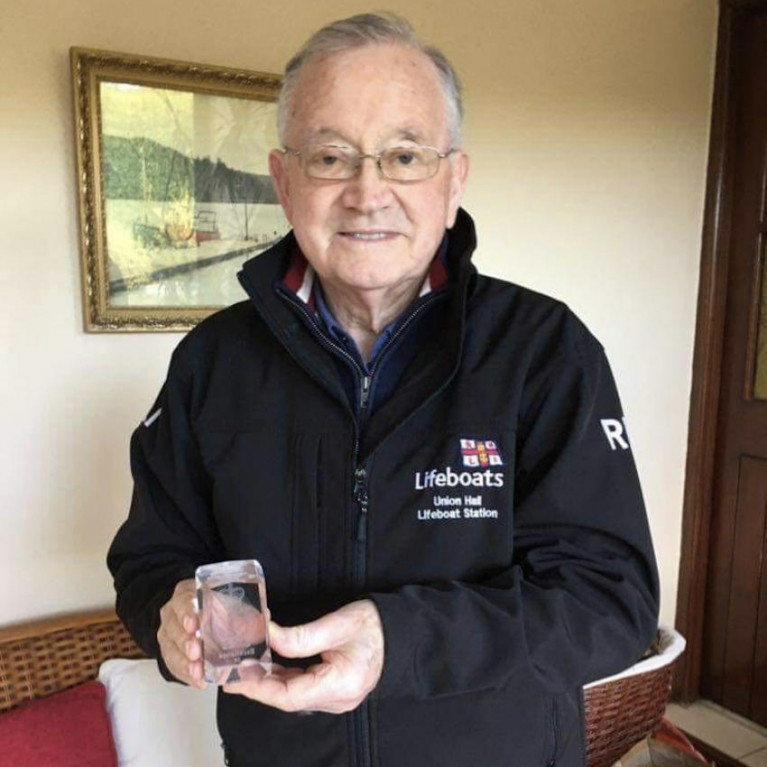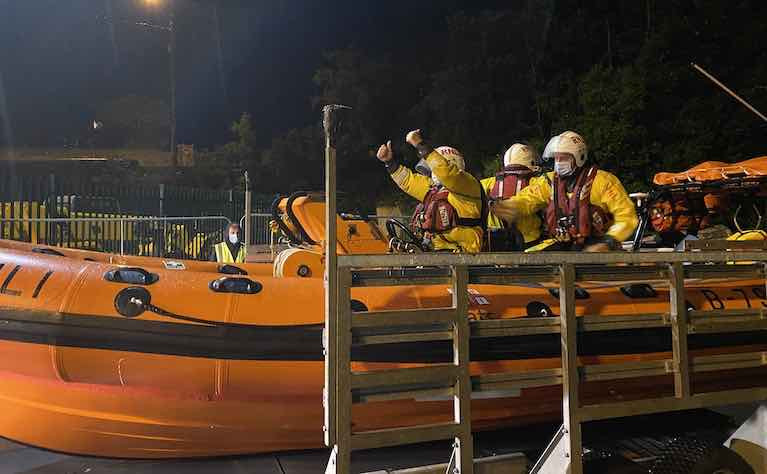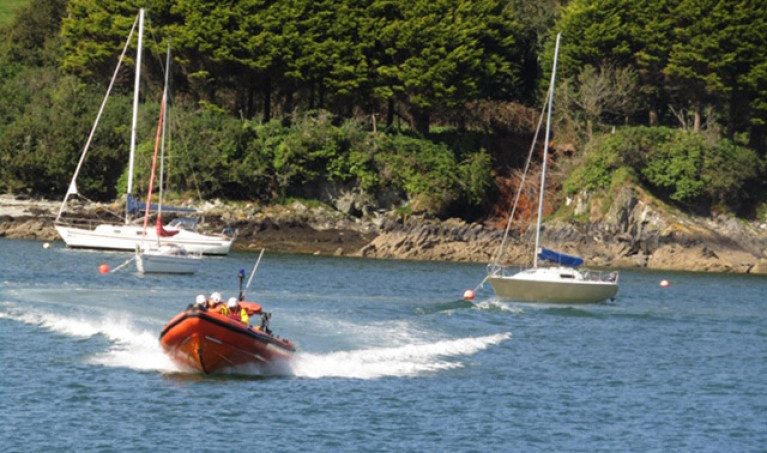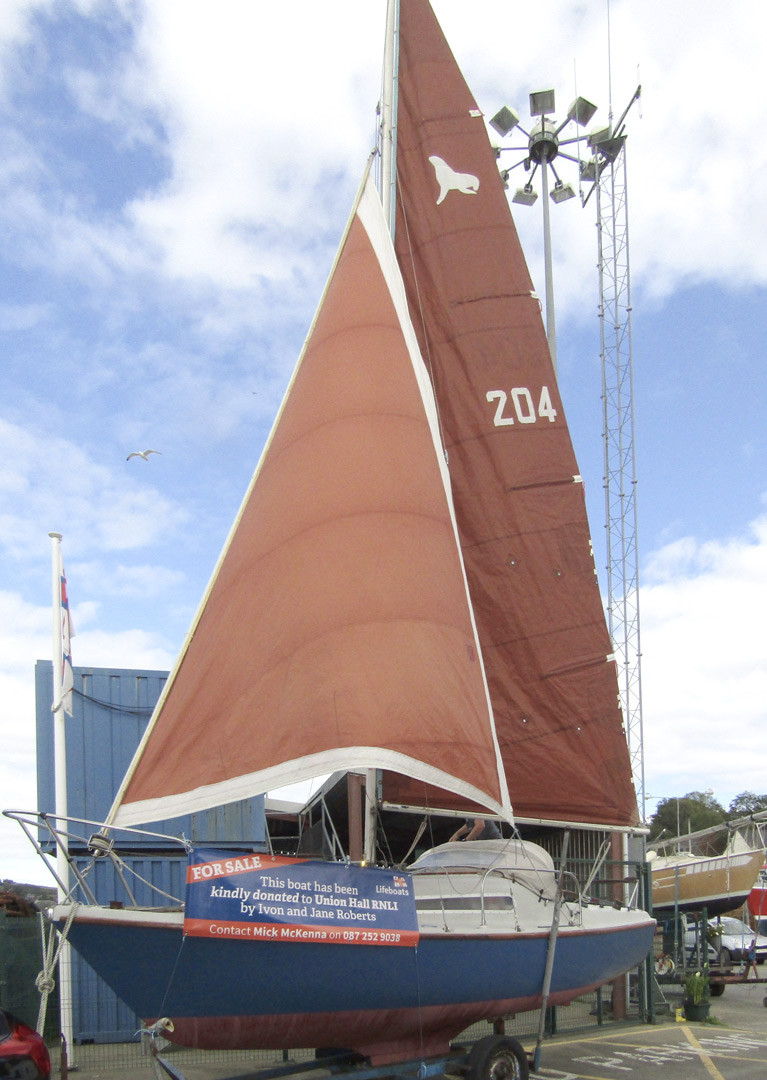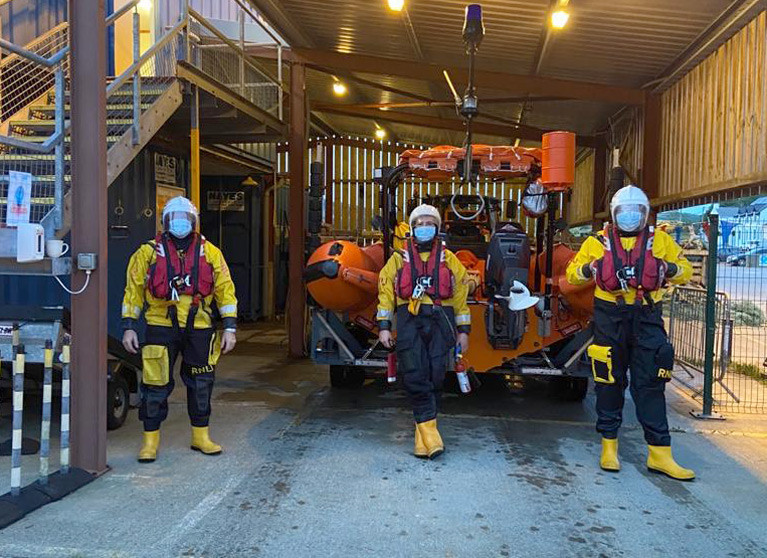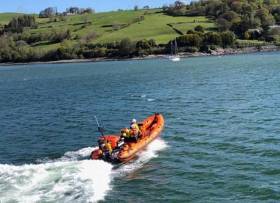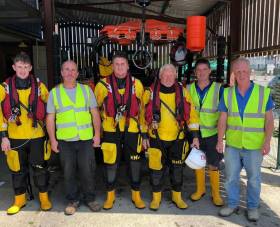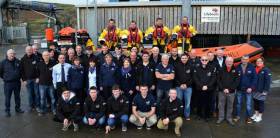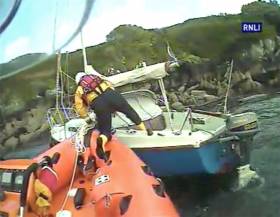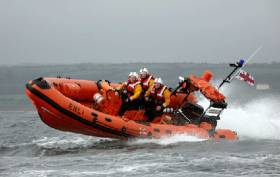Displaying items by tag: Union Hall
Skibbereen Man Receives Union Hall RNLI’s Excellence in Volunteering Award
Union Hall RNLI volunteer Brian Crowley has received an Excellence in Volunteering Award from the RNLI for his hard work, dedication to and promotion of the charity that saves lives at sea.
Unfortunately due to pandemic restrictions, the lifeboat station could not present him with his award in person but hopes to mark this achievement next year.
“This is such an achievement as Brian is volunteering with the RNLI for ‘only’ 66 years so far,” said Pamela Deasey, Union Hall RNLI’s press officer.
“He was asked then to join by Mrs Bridges in Glandore, and he said ‘Yes’ straight away. As a young man growing up in Union Hall, he was aware of the dangers of the sea, and he wanted to raise awareness and help raise vital funds for the service.”
Brian was well-known throughout West Cork at the time as he used to co-own the ever popular Crowley’s Hall in Union Hall, where many a West Cork couple met — his first undertaking as fundraiser was a dance which was a tremendous success.
He became secretary of Leap, Glandore and Union Hall branch in 1976 as well as filling in a lot of other roles, until the current branch set up in 1997.
“Words like dependable, trustworthy, selfless and courageous are the ethos of the RNLI and Brian has proved to be a great ambassador having these qualities in abundance,” Pamela added.
“This is not Brian’s first award, as he also received his silver badge for fundraising in 1985 and a gold badge in 2003. He has many a story to tell about all his years service and all the tremendous characters he has met along his way.”
Speaking following news of the award, Mick McKenna, chair of fundraising at Union Hall RNLI, said: “Everyone at Union Hall RNLI would like to firstly congratulate Brian for this much deserved award, and secondly thank him for all his time, efforts and dedication throughout all these years, in helping to raise vital funds for the RNLI. We are all extremely proud of his achievements.”
Union Hall RNLI Launches Fishing Vessel with Engine Difficulty
The RNLI lifeboat crew was requested to launch their inshore lifeboat Margaret Bench of Solihull, this morning at 5.37 am to a fishing vessel, with two people onboard, that was just west of Glandore harbour in West Cork.
The lifeboat helmed by Chris Collins with Darren Collins and Jordan Limrick onboard, launched at 5.46 am and made its way to the area where the vessel was fishing.
Once on scene, the volunteer crew spoke with the two people, who were well and wearing life jackets. A lifeboat crew member went aboard as the boat was experiencing engine trouble and attached a towline. The boat was towed back to Union Hall pier and tied up. The lifeboat was back on station at 7.05 am.
Speaking following the callout John Kelleher, Union Hall RNLI Lifeboat Operations Manager said: ‘We would remind everyone going to sea always carry a means of communication, wear a life jacket and respect the water.
The Union Hall RNLI lifeboat crew in West Cork were requested by the Irish Coast Guard to launch their inshore lifeboat Margaret Bench of Solihull, this afternoon (Wednesday 15 July) at 3.24 pm to a motorboat, approx 8 metres in length, with four adults and eight children on board. The vessel was propped at the eastern point of Myross Island, west of Glandore Harbour in West Cork.
The lifeboat helmed by Tim Forde with Darren Collins and Sean Walsh on board, launched at 3.35 pm and made its way to the scene arriving at 3.40 pm.
 The Union Hall RNLI crew at their station in West Cork
The Union Hall RNLI crew at their station in West Cork
Once on scene, the volunteer crew spoke with the people aboard, as the boat was propped they attached a towline and towed the boat back to Glandore Pier.
Speaking following the call out Jim Moloney, Union Hall RNLI Deputy Launch Authority said: ‘they did everything right on board, when they realised they were propped they called for help and everyone was wearing life jackets. We would remind everyone going to sea always carry a means of communication, wear a life jacket and respect the water’.
Thanks to the generosity of Ivon and Jane Roberts from Rosscarbery, County Cork, you now can be the next owner as the couple has donated their boat Decade to Union Hall RNLI.
Ivon and Jane bought Decade on their tenth wedding anniversary 23 years ago and now with their crew Jessica and Ivon after flying the nest, they are looking for a new purchase. Decade is a Seal 22 Mark 2 boat, approximately 21ft in length and comes with the trailer.
 (From left to right) Jane & Ivon Roberts, Harriet O’Regan, Jim Moloney, Mary Jacinta Casey, Carmel & Mick McKenna
(From left to right) Jane & Ivon Roberts, Harriet O’Regan, Jim Moloney, Mary Jacinta Casey, Carmel & Mick McKenna
Pamela Deasy, Union Hall RNLI said: ‘The team at Union Hall RNLI want to thank Ivon and Jane for their generous donation. Due to the Covid-19 pandemic all fundraising events have been cancelled bar those of a virtual nature so this opens the door for a new owner, the next chapter of Decade while also raising funds for Union Hall RNLI. The fundraising team also want to thank Garrett O’Mahony, harbour master and Cork County Council for facilitating the boat on Union Hall pier.’
Ivon comes from a family steeped in maritime heritage and his great grandfather Richard Roberts was Captain of the Sirius which was the first wooden-hulled side steamship built-in 1837 to cross the Atlantic.
The boat is on a single axle trailer on Union Hall pier ready to go sailing.
For further information on how to make an offer to purchase the vessel, people are asked to contact Mick McKenna on 087 252 9038.
Union Hall RNLI Lifeboats Tows Yacht Home in Light Winds
Union Hall RNLI in West Cork was requested to launch last night (Wednesday) at 9.01 pm to reports of a yacht with engine difficulty in very light winds.
The volunteer lifeboat crew helmed by Chris Collins, with Cathal Deasy and Jordan Limrick were quickly underway to the yacht which was half a mile east of high island just outside Glandore harbour with four persons on board.
A tow line was quickly established between the yacht and the inshore lifeboat Margaret Bench of Solihull, and the yacht was towed back into the pier at Union Hall. The conditions at sea were calm but with little or no wind.
Union Hall RNLI Rescues Family of Four After 15m Cruiser Strikes Rocks off Glandore Harbour
Union Hall RNLI rescued a family of four this morning after they issued a Mayday when their 15m cruiser struck rocks and started to rapidly take on water off Glandore Harbour in West Cork.
The volunteer crew were requested to launch their inshore lifeboat by the Irish Coast Guard at 10.34am following the Mayday and asked to go to the scene west of Glandore Harbour.
The lifeboat helmed by Aodh O’Donnell and with crew members Shane Hurley and Jordan Limrick onboard, launched immediately and made its way the short distance south of Rabbit Island. Toe Head and Glandore Coast Guard units were also tasked.
Weather conditions at the time were cloudy but good with calm seas and a Force 1-2 north easterly wind.
Once on scene, the lifeboat crew observed that the vessel had headed for shore due to the intake of water and the skipper had managed to beach the boat into the safety of Carrigillihy Harbour.
The crew assessed that the casualties were safe and well before transferring the two adults and two children onto the lifeboat and bringing them safely back to shore where they were made comfortable at the lifeboat station in Union Hall.
Speaking following the call out, Peter Deasy, Union Hall RNLI Deputy Launching Authority said: ‘This was quite a serious incident this morning and the family who were competent seafarers took immediate action and issued a Mayday when they knew they were in difficulty. They were all wearing their lifejackets at the time which is always important in situations like these.
‘As we continue to enjoy the summer, we would remind all users of the sea regardless of activity, to always respect the water. Always wear a lifejacket, always carry a means of communication and always let someone on the shore know where you are going and when you are due back. Should you get into difficulty, call 999 or 112 and ask for the Coast Guard.’
Union Hall RNLI assisted a swimmer who was reported missing off Owenahincha Beach this afternoon.
The volunteer crew was requested by the Irish Coast Guard to launch their inshore lifeboat at 1.24pm after the alarm was raised by a lifeguard that a strong swimmer was missing for 15 minutes off Owenahincha Beach in west Cork, and last spotted near an area notorious for tidal currents.
The lifeboat helmed by Chris Collins and with Charlie Deasy and Dan Collins onboard, launched at 1.30pm and made its way to the scene three nautical miles east of the harbour arriving at 1.48pm.
Weather conditions were poor at the time with a south east Force 6, gusting Force 7 wind and a big swell.
The Irish Coast Guard helicopter Rescue 115 from Shannon was also tasked along with the local Coast Guard unit from Castlefreke.
Once on scene, the lifeboat first conducted a search around the rocks where the swimmer was last seen. Due to the tidal and wind conditions, the lifeboat proceeded to conduct a westerly search and successfully located the swimmer in 10 minutes near Rosscarbery Pier. The swimmer was in a good condition and the lifeboat proceeded to escort the man safely to shore.
Speaking following the call out, Jim Moloney, Union Hall RNLI Deputy Launching Authority said: ‘We are delighted that the swimmer was safe and well when we located him, and we were happy to escort him safely to shore. We would like to commend the lifeguard for his vigilance and prompt actions as the area can be notorious for tidal currents and conditions at sea were not good at the time.’
Union Hall RNLI to be Formally Established on a Permanent Basis
Volunteers at Union Hall RNLI are celebrating the news that their lifeboat station in West Cork is to be formally established following a successful trial.
The recommendation subject to the provision of a long term shoreworks solution was approved at a recent meeting of the RNLI Trustees.
The RNLI’s 45th lifeboat station in Ireland had been officially put on service at Union Hall in 2014 for a trial period that has lasted three years.
This followed representations that were initially made to the RNLI for a declared search and rescue asset to be established at Union Hall in February 2013.
Since then, the station has operated Maritime Nation, a B class Atlantic 75 lifeboat, from temporary station facilities, launching from a slipway adjacent to Keelbeg pier. Work will now commence towards establishing a permanent building and facilities for the station.
Since going on service, Union Hall RNLI has launched 26 times, saved one life and rescued 42 people.
The station’s lifeboat operates approximately eight miles to the west and 14 miles to the east of the greater Glandore Bay area. It is a popular spot for fishermen and visitors including anglers, rowers, swimmers and sailors. The station is flanked by Courtmacsherry RNLI to the east and Baltimore RNLI to the west.
John Kelleher, Union Hall RNLI Lifeboat Operations Manager confirmed that the station had received word from the RNLI Trustees that the trial had been a success and the station, subject to a shoreworks solution, will be made permanent.
‘We have been waiting for this news and to finally get confirmation that the trial has been a success is great - I am delighted not just for our volunteer crew and station management but for everyone who has been involved and supported the setting up of a station here in the locality.
‘I would like to commend the commitment and dedication of our volunteer crew members who have devoted their time to training and to learning and developing new skills to help them save lives at sea. It is thanks to their efforts and those working so hard on the shore - be it to prepare the lifeboat to go to sea or washing it down after a call out, or to educate people about the dangers of water, or to fundraise - that we are now able to provide this service permanently to the community in West Cork and to anyone who may find themselves in distress at sea.’
Paddy O’Donovan, Union Hall Chairman added: ‘I was delighted with the news, it is a vote of confidence in our local volunteers. We wish to thank all the RNLI personnel who visited and helped in this project. We look forward to the next phase in making the station permanent.’
Union Hall Lifeboat Aids Yacht On Rocks In Glandore Harbour
#RNLI - Union Hall RNLI was requested to launch yesterday afternoon (Sunday 10 September) at 4.21pm by Valentia Coast Guard to reports of a yacht that had broken from its mooring in Glandore Harbour and was heading for rocks.
Weather conditions in West Cork at the time were dry with a westerly Force 7 wind, gusting Force 8, and bumpy seas.
The volunteer lifeboat crew were underway at 4.32pm and headed to the yacht just metres from the rocky shore.
Once on scene, a crew member was put aboard the yacht to attach a tow line, and the vessel was pulled to the safety of Union Hall pier.
Speaking following the callout, Union Hall RNLI lifeboat operations manager John Kelleher said the severe windy conditions are set to remain for most of the coming week.
“If you see someone in trouble, please dial 999/112 and ask for the coastguard, and for your safety stay away from exposed coastal areas.”
Teen Anglers Rescued In Glandore Harbour By Union Hall Lifeboat
#RNLI - Union Hall RNLI were tasked yesterday evening (Friday 11 August) by Valentia Coast Guard to a 16ft pleasure craft with five teenagers aboard that suffered engine failure in West Cork’s Glandore Harbour.
The lifeboat was launched and underway at 6.05pm to go to the aid of the casualty vessel, whose passengers had been angling at the eastern entrance of the harbour.
In favourable weather conditions, the Union Hall lifeboat was on scene within a few minutes to assist the pleasure craft as its position was a mere 15 feet away from rocks.
Following the incident, the five teenagers and their parents called to the lifeboat station to thank the volunteer crew for coming to their aid.
Martin Limrick, Union Hall RNLI volunteer lifeboat crew member, said: “The teenagers did everything right. They rang for help, deployed their anchor and were all wearing lifejackets.
“We would urge people when heading out on the water to have a means of communication, always wear a lifejacket and to respect the water.”


























